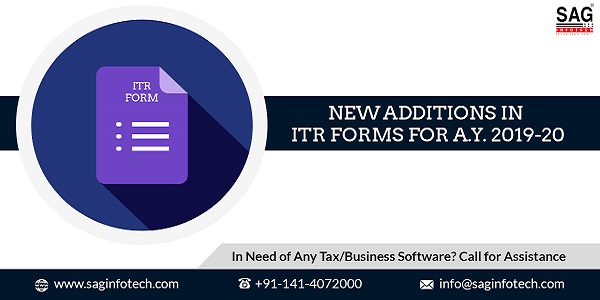The Central Board of Direct Taxes (CBDT) has introduced some changes— particularly more detail seeking disclosures in the new income tax return (ITR) forms for the assessment year 2019-20 to curb tax evasion and wipe out the loopholes.
Considering the revamps and penal clauses for late filing, one should start the process of filing ASAP as the last date for filing income tax returns i.e. 31st July is just around the corner. ITR 1 and ITR 4 are already available on incometaxindiaefiling.gov.in for online filing and the other forms will also be uploaded very soon.
Know about the revisions in ITR 1 and 2 – the most germane forms for individual, salaried taxpayers, and pensioners.

New ITR 1
A new field has been added for a standard deduction under which a flat deduction of Rs 40,000 can be claimed. Similarly, senior citizens can claim exemption of up to Rs 50,000 on interest from savings and fixed as well as post office deposits.
The forms have taken into consideration the announcements made at the time of Union Budget 2018-19.
Unlike last year when taxpayers had to specify only the figure of the income, the revised form seeks the nature of income from other sources as well along with the details of any exempted income & the clause under which the tax benefits have been given, which also includes HRA claimed in the year.
- Additional Disclosures
In the revised ITR 2 the residential status has to be accompanied with complete information about the number of days stayed in India. Until 2018-19, one had to simply opt among the three options- resident, non-resident and resident but not ordinarily resident.
Now Non-resident taxpayers will have to furnish the information about their abroad residency along with their identification number.
“Overseas Citizens of India (OCI) or Persons of Indian Origin (PIO) selecting residential status as ‘non-resident’ in India are required to report the actual number of days in the relevant financial year and also in the last four financial years immediately preceding the year,” said Kuldip Kumar, Partner, PwC.
- Income from Agriculture
Agricultural income is another focus area of the revised form. Now the agricultural income exceeding Rs 5 lakh has to be reported separately under the ‘exempt income schedule alongside surplus information like name of the district & its pin code, size of land, owned or leased, irrigated or rain-fed, etc.
- House buyer’s information
Now the seller of the immovable property will have to mention the buyer’s name, PAN, transaction price and the address of the property. In the condition when there are multiple buyers, revised ITR seeks details of each one of them along with a share in ownership and price paid. The purpose behind the stringent scrutiny is to authenticate the details furnished by the seller and to avert the chances of misreporting.
Restricted use of ITR 1
Following individuals cannot use ITR 1 this year:
- An investor who has invested in unlisted shares.
- An individual who is a director in a company.
- An individual whose agricultural income exceeds Rs 5,000.
Note:
- The form is relevant if your agriculture income is less than Rs 5,000.
- If it exceeds Rs 5,000, use ITR 2.
- Disclosure of unlisted shares
In ITR 2, now you need to disclose the details of all unlisted shares you hold which includes the number of shares, companies’ names, cost of subscription/purchase, PAN, shares transferred during the year, per share issue/purchase price and the closing balance.
Changes in ITR 1 (Sahaj) Forms
- Submission of exempted income details like HRA and mention the nature of income from other sources.
- The additional field for standard deduction and exemption on interest from bank and deposits in post office u/s 80TTB.
Changes in ITR 2
- Detailed information about the number of days spent in India and abroad.
- Detailed information about unlisted shares.
- Details of house buyers, when you have sold an immovable property.
- Submission of additional details concerned with agricultural income like ownership, size & location and status of irrigation.
Individuals who can use ITR 1 (Sahaj)
ITR 1 (Sahaj) can be used by an ordinarily resident individual
with income from salary, interest, and pension of up to Rs 50 lakh
with an agricultural income of Rs 5,000 or less.
who own one house
Individuals who cannot use ITR 1 (Sahaj)
ITR 1 (Sahaj) cannot be used by an individual who :
Is a director in a company
Is an investor in unlisted shares
Has capital gains/losses to declare.
Individuals who can use ITR 2
ITR 2 can be used by a salaried individual or a pensioner who is disallowed to use ITR 1.
ITR 2 can be used by an individual who earns income from any business or profession.






HOW TO FEED ITR 1 RETURN BOUNSE